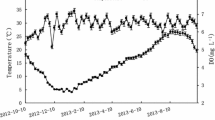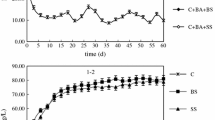Abstract
An integrated multi-trophic aquaculture (IMTA) system consisting of the ascidian Styela clava and the sea cucumber Apostichopus japonicus with microalgae was optimized to increase the commercial cultivation of A. japonicus. The specific growth rate, biochemical composition, and coefficient of variation of A. japonicus were determined as indicators of optimal conditions. The result showed that higher levels of ascidian biomass (800 and 1200 g wet weight m−3) increased the growth rate of A. japonicus while reducing the variation in the weights of the large animals and increasing that of the smaller ones. There was no significant difference in the biochemical composition of same-sized A. japonicus across the ascidian biomass levels examined. Additionally, no significant difference was detected in the A. japonicus cultured with microalgae at a density of 5 × 102 cells ml−1 versus that of 5 × 103 cells ml−1. Thus, the optimal condition for the cultivation of A. japonicus using an IMTA system with S. clava was determined as an ascidian biomass of 800 g wet weight m−3, and the proportion of large to small A. japonicus at 12–28, with 5–6 large and 12–15 small individuals per square meter. Microalga should be cultivated several days before culture and maintained at the density of approximately 500 cells ml−1. This IMTA system can be implemented in A. japonicus cultured in a pond or a seawater mesocosm.





Similar content being viewed by others
References
Bolton JJ, Robertson-Andersson DV, Shuuluka D et al (2009) Growing Ulva (Chlorophyta) in integrated systems as a commercial crop for abalone feed in South Africa: a SWOT analysis. J Appl Phycol 21(5):575–583. doi:10.1007/s10811-008-9385-6
Bosma RH, Verdegem MCJ (2011) Sustainable aquaculture in ponds: principles, practices and limits. Livest Sci 139(1–2):58–68. doi:10.1016/j.livsci.2011.03.017
Buschmann A, Varela D, Hernandez-Gonzalez M et al (2008) Opportunities and challenges for the development of an integrated seaweed-based aquaculture activity in Chile: determining the physiological capabilities of Macrocystis and Gracilaria as biofilters. J Appl Phycol 20(5):571–577. doi:10.1007/s10811-007-9297-x
Chen LH, Xing RL, Jiang AL, Teng L, Wang CH (2015) A preliminary study on the potential value of a novel integrated aquaculture system on water purification. Aquacult Int. doi:10.1007/s10499-015-9958-8
Cooke S, Hill W, Meyer K (2009) Feeding at different plankton densities alters invasive bighead carp (Hypophthalmichthys nobilis) growth and zooplankton species composition. Hydrobiologia 625:185–193. doi:10.1007/s10750-009-9707-y
Cruz-Suarez LE, Leon A, Pena-Rodriguez A et al (2010) Shrimp/Ulva co-culture: a sustainable alternative to diminish the need for artificial feed and improve shrimp quality. Aquaculture 301(1–4):64–68. doi:10.1016/j.aquaculture.2010.01.021
Dong YW, Dong SL, Ji TT (2008) Effect of different thermal regimes on growth and physiological performance of the sea cucumber Apostichopus japonicus Selenka. Aquaculture 275(1–4):329–334. doi:10.1016/j.aquaculture.2007.12.006
Dou SZ, Masuda R, Tanaka M et al (2004) Size hierarchies affecting the social interactions and growth of juvenile Japanese flounder, Paralichthys olivaceus. Aquaculture 233(1–4):237–249. doi:10.1016/j.aquaculture.2003.09.054
Jiang AL, Lin J, Wang CH (2008) Physiological energetics of the ascidian Styela clava in relation to body size and temperature. Comp Biochem Phys A 149(2):129–136. doi:10.1016/j.cbpa.2006.08.047
Ju B, Chen LH, Xing RL et al (2015) A new integrated multi-trophic aquaculture system consisting of Styela clava, microalgae, and Stichopus japonicus. Aquac Int 23(2):471–497. doi:10.1007/s10499-014-9829-8
Kang YH, Shin JA, Kim MS et al (2008) A preliminary study of the bioremediation potential of Codium fragile applied to seaweed integrated multi-trophic aquaculture (IMTA) during the summer. J Appl Phycol 20(2):183–190. doi:10.1007/s10811-007-9204-5
Khoi LV, Fotedar R (2011) Integration of western king prawn (Penaeus latisulcatus Kishinouye, 1896) and green seaweed (Ulva lactuca Linnaeus, 1753) in a closed recirculating aquaculture system. Aquaculture 322:201–209. doi:10.1016/j.aquaculture.2011.09.030
McCarron E, Bumell G, Mouzakitis G (2009) Growth assessment on three size classes of the purple sea urchin Paracentrotus lividus using continuous and intermittent feeding regions. Aquaculture 288:83–91
Mercier A, Battaglene SC, Hamel JF (2000) Periodic movement, recruitment and size-related distribution of the sea cucumber Holothuria scabra in Solomon Islands. Hydrobiologia 440(1–3):81–100. doi:10.1023/a:1004121818691
Neori A (2008) Essential role of seaweed cultivation in integrated multi-trophic aquaculture farms for global expansion of mariculture: an analysis. J Appl Phycol 20(5):567–570. doi:10.1007/s10811-007-9206-3
Paltzat DL, Pearce CM, Barnes PA et al (2008) Growth and production of California sea cucumbers (Parastichopus californicus Stimpson) co-cultured with suspended Pacific oysters (Crassostrea gigas Thunberg). Aquaculture 275(1–4):124–137. doi:10.1016/j.aquaculture.2007.12.014
Ren JS, Stenton-Dozey J, Plew DR et al (2012) An ecosystem model for optimising production in integrated multitrophic aquaculture systems. Ecol Model 246:34–46. doi:10.1016/j.ecolmodel.2012.07.020
Ribes M, Coma R, Atkinson MJ et al (2005) Sponges and ascidians control removal of particulate organic nitrogen from coral reef water. Limnol Oceanogr 50(5):1480–1489
Sanz-Lazaro C, Belando MD, Navarrete-Mier F et al (2011) Effects of wild fish and motile epibenthic invertebrates on the benthos below an open water fish farm. Estuar Coast Shelf Sci 91(2):216–223. doi:10.1016/j.ecss.2010.10.023
Slater MJ, Jeffs AG (2010) Do benthic sediment characteristics explain the distribution of juveniles of the deposit-feeding sea cucumber Australostichopus mollis? J Sea Res 64(3):241–249
Slatera MJ, Cartonb AG (2009) Effect of sea cucumber (Australostichopus mollis) grazing on coastal sediments impacted by mussel farm deposition. Mar Pollut Bull 58(8):1123–1129. doi:10.1016/j.marpolbul.2009.04.008
Troell M, Joyce A, Chopin T et al (2009) Ecological engineering in aquaculture: potential for integrated multi-trophic aquaculture (IMTA) in marine offshore systems. Aquaculture 297(1–4):1–9. doi:10.1016/j.aquaculture.2009.09.010
Uthicke S (2001a) Interactions between sediment-feeders and microalgae on coral reefs: grazing losses versus production enhancement. Mar Ecol Prog Ser 210:125–138. doi:10.3354/meps210125
Uthicke S (2001b) Interactions between sediment-feeders and microalgae on coral reefs: grazing losses versus production enhancement. Mar Ecol Prog Ser 210:125–138. doi:10.3354/meps210125
Vadas RL, Beal B, Dowling T et al (2000a) Experimental field tests of natural algal diets on gonad index and quality in the green sea urchin, Strongylocentrotus droebachiensis: a case for rapid summer production in post-spawned animals. Aquaculture 182(1–2):115–135. doi:10.1016/s0044-8486(99)00254-9
Vadas RL, Beal B, Dowling T et al (2000b) Experimental field tests of natural algal diets on gonad index and quality in the green sea urchin, Strongylocentrotus droebachiensis: a case for rapid summer production in post-spawned animals. Aquaculture 182(1–2):115–135. doi:10.1016/s0044-8486(99)00254-9
Yang HS, Yuan XT, Zhou Y et al (2005) Effects of body size and water temperature on food consumption and growth in the sea cucumber Apostichopus japonicus (Selenka) with special reference to aestivation. Aquac Res 36(11):1085–1092. doi:10.1111/j.1365-2109.2005.01325.x
Yang HS, Zhou Y, Zhang T et al (2006) Metabolic characteristics of sea cucumber Apostichopus japonicus (Selenka) during aestivation. J Exp Mar Biol Ecol 330(2):505–510. doi:10.1016/j.jembe.2005.09.010
Yu Z, Jiang A, Ju B (2014) Effect of the ascidian Styela clava on the growth of small holothurians of the species Apostichopus japonicus. Mar Freshw Behav Physiol 47(4):211–226. doi:10.1080/10236244.2014.929800
Yuan XT, Yang HS, Zhou Y et al (2006) The influence of diets containing dried bivalve feces and/or powdered algae on growth and energy distribution in sea cucumber Apostichopus japonicus (Selenka) (Echinodermata : Holothuroidea). Aquaculture 256(1–4):457–467. doi:10.1016/j.aquaculture.2006.01.029
Zhou Y, Yang HS, Liu SL et al (2006) Feeding and growth on bivalve biodeposits by the deposit feeder Stichopus japonicus Selenka (Echinodennata: Holothuroidea) co-cultured in lantern nets. Aquaculture 256(1–4):510–520. doi:10.1016/j.aquaculture.2006.02.005
Acknowledgments
This study was funded by the National Natural Science Foundation of China (Nos. 31070368, 31572622), the National Natural Science Foundation of Shandong Province (ZR2014CM031, ZR2014DL011), and Open-end Funds of Jiangsu Key Laboratory of Marine Biotechnology, Huaihai Institute of Technology (2015HS005).
Author information
Authors and Affiliations
Corresponding author
Rights and permissions
About this article
Cite this article
Ju, B., Jiang, Al., Xing, Rl. et al. Optimization of conditions for an integrated multi-trophic aquaculture system consisting of sea cucumber Apostichopus japonicus and ascidian Styela clava . Aquacult Int 25, 265–286 (2017). https://doi.org/10.1007/s10499-016-0027-8
Received:
Accepted:
Published:
Issue Date:
DOI: https://doi.org/10.1007/s10499-016-0027-8




